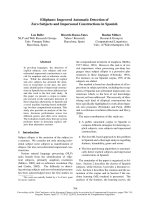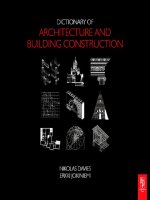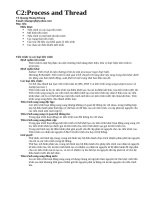Thread And Seam Construction
Bạn đang xem bản rút gọn của tài liệu. Xem và tải ngay bản đầy đủ của tài liệu tại đây (1.88 MB, 52 trang )
THREAD &
SEAM
CONSTRUCTION
BY MACKENZIE WALTON
MARCH 2012
•
Thread sizing conventions
•
Common types of sewing thread
THREAD BASICS
Thread size is determined the same way that yarn size is determined for textiles. While there are different systems, they are all based on weight and length specifications, and not by diameter as might be assumed.
•
METRIC TICKET (Nm)
# of 1,000 metre lengths in 1,000 grams
•
COTTON COUNT (Ne)
# of 840 yard hanks in 1 pound
•
TEX
grams per 10,000 metres
•
DENIER
grams per 9,000 metres
Thread Size
Thread Size
Thread Size
GENERAL GUIDELINES FOR THREAD SIZE SELECTION
SEWING THREAD SIZES BY
TEX
FABRIC WEIGHT
(GSM)
FABRIC WEIGHT
(oz/yd2)
GARMENT EXAMPLES
18, 24 65 - 140 2 - 4 T-shirts, Lingerie
24, 27, 30 140 - 200 4 - 6 Shirts, Dresses
30, 40 200 - 275 6 - 8 Light-Weight Bottoms
40, 60 275 - 400 8 - 12 Light-Weight Denim
60, 80, 105 400 - 500 12 - 15 Heavy-Weight Denim
COTTON THREAD
Generally provides good sewing performance but strength and abrasion resistance is inferior to synthetic threads of equal
thickness
•
Mostly used for piece-dye items
•
Shrinkage may cause puckering after wash/dye
•
Can be mercerized – reduces shrinkage, increases strength and luster, improves dye up-take
Common thread types
COTTON THREAD
MERCERIZATION
Common thread types
SPUN POLYESTER THREAD
Made with staple polyester fibers. Provides good sewing performance, good dimensional stability and
good stitch locking properties due to the fibrous surface.
•
Resistant to sunlight and chemicals
•
Stronger than cotton, including 4X better abrasion resistance
•
Ideal for light to medium weight fabrics
Common thread types
CORESPUN POLYESTER THREAD
Made by spinning staple polyester or cotton fibers around a continuous filament polyester core. Provides enhanced
strength and elongation while maintaining stitch locking ability and can be run at higher speeds without breakages.
•
Higher machine speeds mean an increase in productivity by up to 21%
•
Best thread for heavy fabrics, like denim and outerwear
•
More consistent sewing quality due to better loop formation and resistance to damage
•
Most expensive general purpose sewing thread
Common thread types
TEXTURED FILAMENT THREAD
Continuous filaments of polyester or nylon are entangled by various methods to create softness and bulk. Ideal for overlocking and the looper of
coverseams, these threads provide excellent coverage for raw edges
•
Most economical thread
•
Softness makes it ideal for lopping threads that sit close to the skin
•
Excellent elasticity for stretch fabric applications
•
Often found in intimates, baby clothes, and athletic wear
Common thread types
OTHER THREAD TYPES
•
Mono-filament ‘Invisible’ Thread
•
Embroidery Thread
•
Elastic Thread
•
Specialty – Lurex, Indigo
•
Locked Filament Thread
•
Glow in the Dark
Common thread types
LUBRICATION
Regardless of construction, all threads are finished with a lubricating coating. This facilitates the passage of the thread through the machine and needles, reducing friction and
heat that can cause damage.
LIFE SPAN
Under optimal conditions, thread will last about 18 months before the lubricants start to break down and thread quality starts to deteriorate. Unsurprisingly, most factories do not
store thread in optimal conditions and so this period is usually much shorter.
Common thread types
•
Needle sizing conventions
•
Different Needle Types
NEEDLE BASICS
Needle Sizing
Most sewing is done with rounded-point
needles. Actual cutting points are only
used for leather and similar fabrics. ‘Set
Points’ are normal, lightly rounded points
used for wovens, while knits demand
more rounded needles, referred to as ‘ball points’
Different levels of roundness are identified with letter markers
Needle Types
R = Normal round
•
for light woven fabrics
SPI = Acute round
•
For densely woven fabrics
SES = Light Ball
•
Fine to medium knits, fine denim, medium to heavy wovens
SUK = Medium Ball
•
Stonewashed denims, corsetry
SKF = Heavy Ball
•
Fine elastic materials, coarse knits
SKL = Special Ball
•
Medium to coarse elastic materials, coarse knits, lycra
Needle Types
The fabric and end use will determine the thread size and type, and needle
type that you will use. The chosen thread will determine the needle size.
There will be a range of possible thread sizes and types that can be used
with any given fabric, depending on the application.
Needle-Thread Pairing
•
Seam Types
•
Stitch Types
•
Applications
•
What makes a good seam
SEAM CONSTRUCTION
•
Superimposed Seams (basic simple seam)
•
Lapped Seams
•
Lapped felled seams
•
Flat Seams
•
Bound seams
•
Edge finishing
Seam Types
SUPERIMPOSED SEAMS
STANDARD SEAM FRENCH SEAM
Seam Types
LAPPED SEAMS
LAPPED SEAM
FELLED SEAM
Seam Types
FLAT SEAMS
Seam Types
BOUND SEAMS
Seam Types
EDGE FINISHING
Seam Types
301 - LOCKSTITCH
•
Basic 1-needle straight stitch
•
Uses least amount of thread
•
Tightest and most secure stitch
•
High abrasion resistance due to low profile on the fabric
•
No stretch
Stitch Types
![Tài liệu Local Democracy, Economic Development and Construction Bill [HL] docx](https://media.store123doc.com/images/document/14/br/jt/medium_hdP4QOGe00.jpg)








